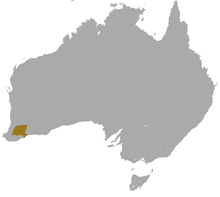Red-tailed phascogale
| Red-tailed phascogale[1] | |
|---|---|

| |
| Scientific classification | |
| Kingdom: | |
| Phylum: | |
| Class: | |
| Infraclass: | |
| Order: | |
| Family: | |
| Genus: | |
| Species: | P. calura
|
| Binomial name | |
| Phascogale calura Gould, 1844
| |

| |
| Red-tailed phascogale range | |
The red-tailed phascogale (Phascogale calura), also known as the red-tailed wambenger, is a small carnivorous marsupial found in central and western Australia. It is closely related to the brush-tailed phascogale (Phascogale tapoatafa), but is smaller and browner.
Taxonomy
The red-tailed phascogale is one of only two members of the phascogale genus, the other being the brush-tailed phascogale (P. tapoatafa). The species was described in 1844 by naturalist and artist John Gould. Its scientific name means "beautiful-tailed pouched-weasel".[3]
Description

The red-tailed phascogale is smaller and browner than its close relative the brush-tailed phascogale. As in the brush-tailed phascogale, male red-tailed phascogales die following their first mating as a result of stress-related diseases.[4] Males rarely live past 11.5 months, although females can live to three years old. Captive males can also survive up to three years.[3] An arboreal species, the red-tailed phascogale has a varied diet, and can feed on insects and spiders, but also small birds and small mammals, notably the house mouse (Mus musculus), which has become ubiquitous in the landscape since its introduction by Europeans; it does not drink as its water is metabolised through its food.[3]
Distribution and habitat
The red-tailed phascogale was formerly widespread throughout central and western Australia but is now restricted to the southern Western Australian wheatbelt,[5] and is classified as near threatened by the IUCN Red List and endangered by the Australian EPBC Act. It is found in dense and tall climax vegetation, and appears to prefer those containing the Wandoo (Eucalyptus wandoo) and the Rock Sheoak (Allocasuarina huegeliana), as it has developed a resistance to the fluoroacetate the plants produce that is lethal to livestock.[3] Most native animals have a resistance to this fluoracetate, but introduced species, like the red fox (Vulpes vulpes), do not, so it has been suggested that the red-tailed phascogale's survival in these areas could be attributed to this chemical.[3] The species was reintroduced to the Wadderin Sanctuary in the central wheatbelt of Western Australia in 2009.
References
- ^ Groves, C. P. (2005). Wilson, D. E.; Reeder, D. M. (eds.). Mammal Species of the World: A Taxonomic and Geographic Reference (3rd ed.). Baltimore: Johns Hopkins University Press. pp. 31–32. ISBN 0-801-88221-4. OCLC 62265494.
- ^ Template:IUCN2008
- ^ a b c d e Bradley, A. J. (1995), "Red-tailed Phascogale", in Strahan, Ronald (ed.), The Mammals of Australia, Reed Books, pp. 102–103, ISBN 0-7301-0484-2
- ^ Menkhorst, Peter; Knight, Frank (2001), A Field Guide to the Mammals of Australia, Oxford University Press, p. 50, ISBN 0-19-550870-X
- ^ Short, J.; Hide, A (2012). "Distribution and status of the red-tailed phascogale Phascogale calura". Australian Mammalogy. 34: 88–99.
External links
- AustralianFauna.com
- Australian Department of Environment and Heritage Species Profiles, features distribution map

